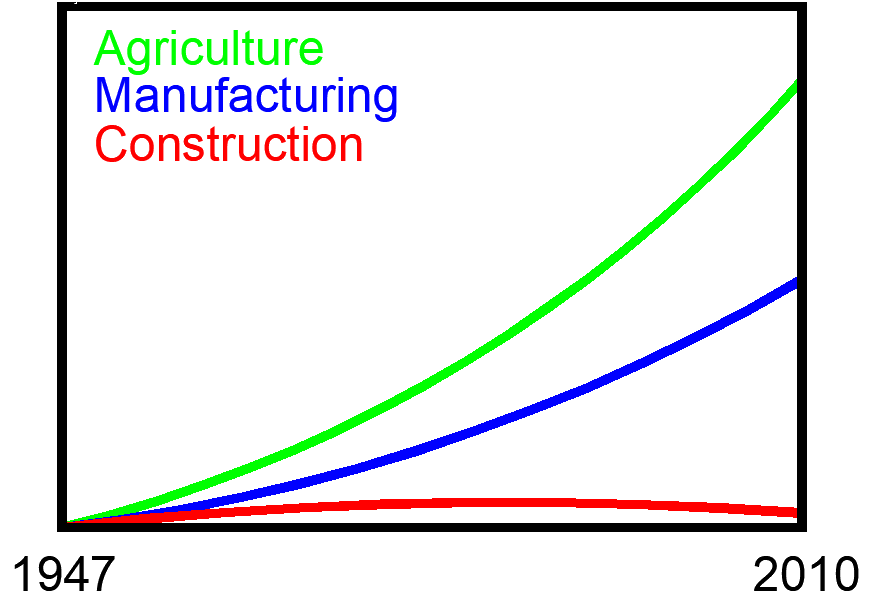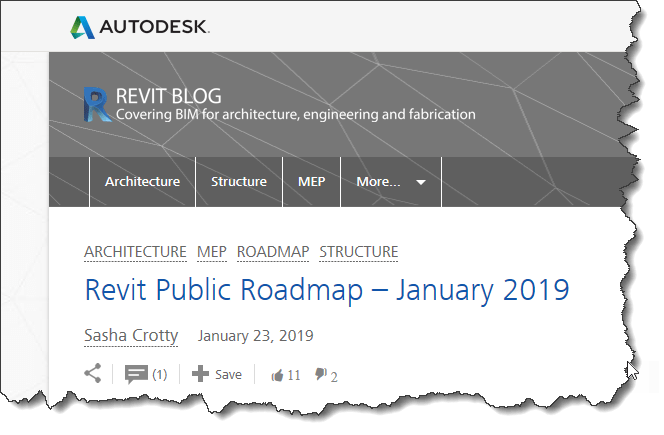The Construction Productivity Lie
Most in the construction industry is familiar with the report from McKinsey a few years past as well as others. The report outlines how Construction lags behind almost every other industry in terms of productivity. It looks something like this…

Shortly after Autodesk acquired PlanGrid was when I really started to get annoyed about these statistics. It was during an evening dinner hosted in Seattle for local construction industry leaders. Autodesk and PlanGrid were presenting their vision of the future together.
In attendance were competitors, trade partners, general contractors and owners from the all the firms you think of when you think Seattle construction. Generally speaking, it was a good meeting. That is until a particular Autodesk executive took his turn at the microphone.
Like a well rehearsed orchestra, out comes the productivity chart with his statement that construction productivity has been flat for 20 years. Without skipping a beat, he informed the group that the ONLY explanation was that as contractors, we’ll “Work as Slow as you let them or as Fast as you Make them.“.
Anecdotal stories from industry trades men and women always made me suspect that data was misleading. Stories of how a 1 million sq/ft hospital use to be a 5 year project and now a good team can knock it out under a year. We’ve shifted a lot of work from the field to the shop and there’s really no benefit? Nonsense!
Sometimes when you start making improvements the benefits don’t first appear where you think. When you first turn on the A/C in a home in a warm humid climate, you start feeling more comfortable almost immediately. Except the first thing to lower is humidity, not temperature. Improvements in the construction process starting in the early 2000’s had benefits, they just may not have shown up in the poor metrics historically used to measure productivity. Similar trends were observed with technology in general. There was a lag between Silicon Valley tech’s offerings and results in business processes. It takes time to realign business ecosystems.
An Alternate View
My nature is to question everything and everyone. Even I don’t escape this scrutiny myself as I’m usually my toughest critic. I’ve encountered too many instances where reality was 180 degrees opposite of what was considered obvious.
While that McKinsey report was important for our industry, it’s also been very misused. Instead of the explanation being that we work as slow as allowed and as fast as we’re made to, I have another theory. The software we’ve been sold for 20+ years promising increased productivity and efficiency has done nothing.
To be fair, this story isn’t limited to Autodesk as plenty of other software vendors like to misuse this productivity data. I also don’t think technology has had zero benefit either. The debate on either side is largely hypothetical. Rather the problem is more complex and the description of the problem is also likely flawed in many ways.
What’s Behind The Numbers
The first place you need to look, is where do the numbers come from? McKinsey’s data comes from a number of sources including international. In the US, that data comes from the US Bureau of Labor Statistics. Only recently did the BLS start aggregating data from specific construction sectors. Those sectors are as follows…
- Single Family Residential Construction
- Multi-Family Residential Construction
- Industrial Building Construction
- Road and Bridge Construction
Prior to getting these more sector specific numbers, they simply applied productivity from Single Family construction to the entire construction sector as a whole. Data points simply weren’t available for anything better. The above sectors don’t accurately reflect much of commercial construction where software and services dominate the focus of sales efforts by vendors.
Simply put, we’re measuring a lot of different things. Measuring them poorly and lumping them all together to get a half-assed number. They’re not good numbers but they are better then nothing. Even the BLS talks about the difficulty in obtaining good data due to various factors. One such factor is that labor from subcontractors is NOT included in the data. It’s treated like purchased materials for the purposes of BLS data collection. Subcontractors were predominantly where early prefabrication occurred. Not at the general contractor level.
That begs to question, as we move more to product manufacturing in construction, does more of that dollar value shift out of the productivity stats? It doesn’t shift labor equally to the shop as there’s still onsite assembly needed. Much like outsourcing anything, it’s not a 100% shift in labor as there’s now project management involved when outsourcing so labor actually increases. I suspect a shift to industrialized construction will not show well using current productivity measurement methods. We’ve separated the manufacturing and assembly resulting in increased labor. How does this affect the numbers?
But don’t take my word for it, dig into the data and publications yourself. There’s some good reading.
https://www.bls.gov/lpc/construction.htm
A Gross Misuse Of The Data
While construction productivity is a story our industry needs to hear, we need you ensure the data is used within the proper context. To start with, those “Productivity Charts” don’t actually report “Productivity“. Rather, they report “Productivity Change“. Those are two vastly different things.
If you compared the most vs least productive activities against each other over time, one will likely show drastic improvements in one while the other shows little. That doesn’t mean the activity with little improvement is somehow the laggard or in drastic need of disruption. Simply put, some activities have more low hanging fruit than others.
Secondly, the nice things about charts is you can make them say anything. Looking at that earlier productivity chart, did Agriculture, Manufacturing and Construction all magically start out with equal productivity in 1947? Unlikely. Let’s look at that data in a complete reverse manner…

Same exact curves, but displayed differently. Is Construction a laggard or did Agriculture and Manufacturing just get their shit together finally?
Construction has so many variables and is so difficult to compare, that most of these charts compare against dollar value for lack of anything better. That is likely the best number to use as poor as it is, but Dollars to Hours ratios are not the same across trades, materials, geographic regions, construction types, etc. Nothing has perfectly equal economic value.
Don’t get me wrong. I’m not suggesting Construction is the lens that other industries should look at themselves through. Having transitioned from Manufacturing to Construction in 2008 myself, I see a lot we’re doing wrong and there’s dirty laundry everywhere. However when you look at the same data from a different perspective, it suggests that there’s more to the story. It’s not the picture much of the industry prognosticators and technology pundits suggest in an effort to peddle their wares.
Dissimilar Manufacturing Models
When you think of Manufacturing and increasing productivity what do you think of? High volume standard products? Or do you think of single individual custom products? Now how about construction? High volume standard buildings or custom?
Most of the world is made of standard products not custom. From milk cartons to dental tools to cars, most everything you use is a standardized product. If not, they’re assembled from standardized products. Productivity gains in manufacturing come from highly refined processes, assembly lines, standardized parts, simplification and automation. These things take significant overhead investment and volume to recoup the capital they require. There are millions of products on the market and each of those have a scale of units sold.
This isn’t really the case for construction. Construction is predominantly a large custom machine assembly activity. While there’s an increasing number of “products” going into a buildings, the ratio of standard products to custom will never be the same. Where a manufactured product requires custom parts, there’s usually a ‘volume’ component to the equation. And where there’s parts in a product, they’re assembled in similar or the same way in each unit. This also isn’t the case for construction now and never will be IMO. It’ll trend toward manufacturing, but the movement in that direction will always be less than the gap that still exists for much of commercial construction.
One last contrast between manufacturing models is at the task level. Much of manufacturing is automated or comprised of single person tasks. Contrast this to construction where due to size and scale, many tasks are performed using multiple people. It’s far easier to automate one person than an entire team.
Scope and Scale
Another key difference between manufacturing and construction is in the scale of the activity. In a nutshell the larger physically a product is and/or the more parts/complexity it contains the longer the cycle time. We can buy most any power hand tool with almost zero lead time. A major $250-500k machine tool like a 5-Axis mill is going to have a lead time from a few months to even a year or more depending on backlog.
A building is really just a large machine. Likely the largest machine that’s commonly built. And it’s complexity is likely only rivaled by products like a jet airliner. It should be noted that a 737 from order to delivery takes about 24 months and that’s a multiple unit production activity with a sometimes decades long design process.
One reason size matters is distance, Everything I need to assemble most products can be within an arm’s reach or done on an assembly line (multiple units). Have you considered the distances of material and workers in construction? Vertical transportation alone in a high rise is a significant factor in productivity. Same components…just higher up in the air. It’s not really fair to compare manufacturing productivity with the productivity of building a cross country highway. And when was the last time you’ve had the entire population of a city core commuting through your manufacturing facility while you’re moving materials into position? Does a factory floor material handler need oversize load permits? Coordinate a city street shutdown for a crane pick?
Complexity
If you look at the history of manufacturing, a lot of work has been outsourced globally. In the last 2 decades, a lot of that work has been brought back. With a focus on reducing complexity, ease of manufacturing and assemble (DfMA) manufactured products have become…simpler. Electronics and computers now replace complex mechanisms,
Construction on the other hand is trending in the other direction. Prefabrication and modularization takes added time and materials making things more complex. That complexity in manufacturing is a trade off for simplicity and safety in assembly on site…the actual build. It’s also what’s required to speed on-site construction and scale a physical location that can’t easily be scaled. It doesn’t in itself save time or material in many cases. It can actually increase these factors.
Simply put, product manufacturing used raw materials to make parts to make products. Construction used raw materials to make it’s product…little use of parts. Industrialized construction is inserting “product” into the process. That’s an extra step that didn’t exist before and productivity is not likely to be the first result you’re going to see. The benefits are elsewhere not productivity (quality, safety, scalability, speet of assembly/build, etc.)
In addition to prefab and modular trends, systems are more complex and new materials being developed in the name of energy efficiency and safety. With these systems comes significant financial risk. You could recall entire product lines and replace them for the price of a failed construction project like the Harmon Tower in Las Vegas. Do a quick internet search for the litigation around construction failures using Aquatherm piping in the US….a product that’s proven itself in other markets but was often misused during it’s entry to the US market. When you insert new risk, it’s going to cost money and/or time.
Customer Business Models
Everyone wants an iPhone. It’s trendy like many products. How many people want the same home or office? How many building owners even use their building the same way? Buildings aren’t bought the same way or using the same criteria as manufactured products. The financing isn’t even the same.
Value is defined by the customer and what they’re willing to pay for. For products, it’s typically reliability, utility, fashion and/or often price. In construction, those things are important too but there are other factors. Some of those other factors often cause waste in other areas like labor and materials which cast a dark shadow on productivity.
Lets examine a couple real world examples I’ve seen….
Example 1: Hospital construction schedule necessitates overtime. The following week, it’s layoffs and a complete shutdown. Why? The healthcare company wants to buy another chain and an open construction product on the books creates an obstacle for the bankers, accountants and lawyers. No worries, it’ll pick back up in 6 months. In the mean time, you have a huge hole in your schedule with no time to fill. 6 months from now, you’re already booked and the labor halls have empty benches. How’s your productivity now? Ultimately the customer did what made sound business sense for them but injected added cost and waste into the process.
Example 2: Your doing a tenant improvement (TI) project. There’s another team doing the Shell and Core. You could really make use of their tower crane but they’re going to demobilize. After all, they work for the developer who wants to take their money and move on. Again, sound business for the developer, but which costs time and productivity to the tenant’s TI.
No Waiting or Digitization Required
How many projects do you know where the construction schedule is ahead of the design schedule? All to common right? We don’t have time to wait while 100% of the design is finalized. We make calculated decisions based on risk of change and move forward. Construction has a low digitization rate and lacks sophisticated supply chains. In practical terms this means construction is VERY agile. That’s right…Analog IS Agile.
All those digital tools and integrated workflows. None of that is needed to build. All you need are People, Material and Tools. Simple materials and simple tools. And simply put, until recently, the technology did not exist to properly manage that volume of data is a collaborative way. The Cloud has really helped here but it’s use as a collaborative tool in construction is still in it’s infancy.
Economic Risk
Another key difference between construction and manufacturing is the economic risk. Factory expansions get canceled or accelerated. But there’s also market research into number of customers and many other factors. It’s easier to scale your plans up/down or outsource fabrication and still get a large portion of your desired value. In construction, your customer is typically buying 1 of something. Half a fence isn’t 50% effective so it’s scalability during economic uncertainty is less elastic. We might scale back quality of furniture or advanced systems for energy savings but the building will get built or not. There’s not a lot of in-between.
Construction is also the largest capital investment someone will make. In a short decade (2008-2018), we went from a “Labor shortage“, to “Never Have enough jobs again” to “Labor shortage“. That type of economic swing does not lend itself well to investment in construction. It also doesn’t help you invest in building an industrial complex for construction. Detroit’s automotive industry, with it’s existing infrastructure has almost went out of business more than once in my lifetime. There’s no significant workforce still building cars by hand.
Accelerate that business cycle from my 50 years of life to a decade. Trying to build a brand new infrastructure to support industrialized construction isn’t going to happen over night. Most think Katerra failed. I think it was a hell of a win. To do what they did at the scale they did for as long as it went on was impressive. But it was an anomaly at best. Likely only facilitated by undisciplined business evaluations by speculators looking for a unicorn. Financial gamesmanship allowed Katerra to do what they shouldn’t have been able given the timeline involved. They paid dearly for that gamble. The industry as a hole has benefited. Industry innovators and disruptors often only serve to break the dam. Others behind it are often the floodwaters you were expecting.
Different Social Engagement
Construction is also a very social activity. This repeats each and every time. Manufacturing on the other hand is social during design and perhaps production startup. Even then it’s still considerably less social. After design and process definition, manufacturing becomes very transactional. When’s the last building you saw go up that was on auto-pilot? I don’t see the consumers of the built environment purchasing transitionally as a rule of thumb outside a few narrow edge cases.
Additive manufacturing (3d Printing) is perhaps the best hope of an “Auto pilot” for construction. It’s the sexy new thing in all the trade media publications and news articles. But I’ve yet to see a mechanical room printed in 3d. I’ve not seen how they’ve 3d printed embedded conduit or voids for electrical. And I’ve not heard of any new record tall skyscraper built this way. When Boeing has the largest buildings on earth (by volume) to build a jet, imagine them larger to build a 40-story highrise and make those production facilities mobile. That’s what we’re up against.
Regulatory Differences
The last difference I’ll highlight is the regulatory environment construction operates under. Does the city council and their various committees dictate the size, quantity or color of the buttons on the machine you’re manufacturing? Do community groups protest the look of your products and demand that they have a similar feel as the rest of the products in your home?
Safety is another where the regulatory differences are striking. No industry is exempt. But they are targeted. Be it fishing, robotic cell design, chemical processing…there’s usually a limited scope to much of the regulations being pushed in the manufacturing space. In construction, those regulations sweep broadly across the whole industry. Much of this is insurance and litigation driven as well. In these cases, time is money and money wins. I’ve yet to buy a car and have a discussion with a dealer about bonding, lien wavers, or if my coverage will be OCIP or CCIP (Owner Controlled vs Contractor Controlled Insurance Plan). Financing a car is fairly straight forward. A building is not. Risk drives this and it will affect productivity.
I’m certainly not disputing the value of safety. However every moment you’re setting up/taking down safety gear and not holding a pipe is increased labor cost. In a manufacturing world, those measures tend to be more permanent, not repetitively relocated. They’re also more easily automated in manufacturing if human waste can’t be extracted any other way.
That’s a Wrap
Again, the point of all this isn’t that I think Construction don’t need to improve or change. It does. Safety is critical. So is energy and material usage. The point I’m trying to make is this….We don’t need to be brow beat into buying anyone’s product. None of them are going to save our industry by themselves. Our industry is doing quite well and is headed in the right direction. It just takes time to change an industry and build and new industrial complex to feed it.
I hope the next time you hear someone casually throwing out construction productivity stats, you’re more likely to push back. Empty slogans and catch phrases have no place in disrupting our industry. Sound business and data driven decisions do. Don’t let them bull shit you any more.
A bit if Personal History
PS: The below photo is of my child hood home I moved into in 4th grade. It was built in 1975 in a rural part of Michigan with a county population less than 8500 residents. It was a prefabricated home. All floor plates, walls and roof trusses were delivered in 3 open top semi trailers and assembled via crane over a full concrete block foundation in the course of a day. That was 45 years ago and it’s still not mainstream today. Things change slower than you realize and only to appear to have changed quickly in hindsight. Industry disruptors rarely destroy entire industries overnight. While there’s a lot of runway ahead, if you objectively look back 10-15 years, you’ll see we’ve come a hell of a long way.




